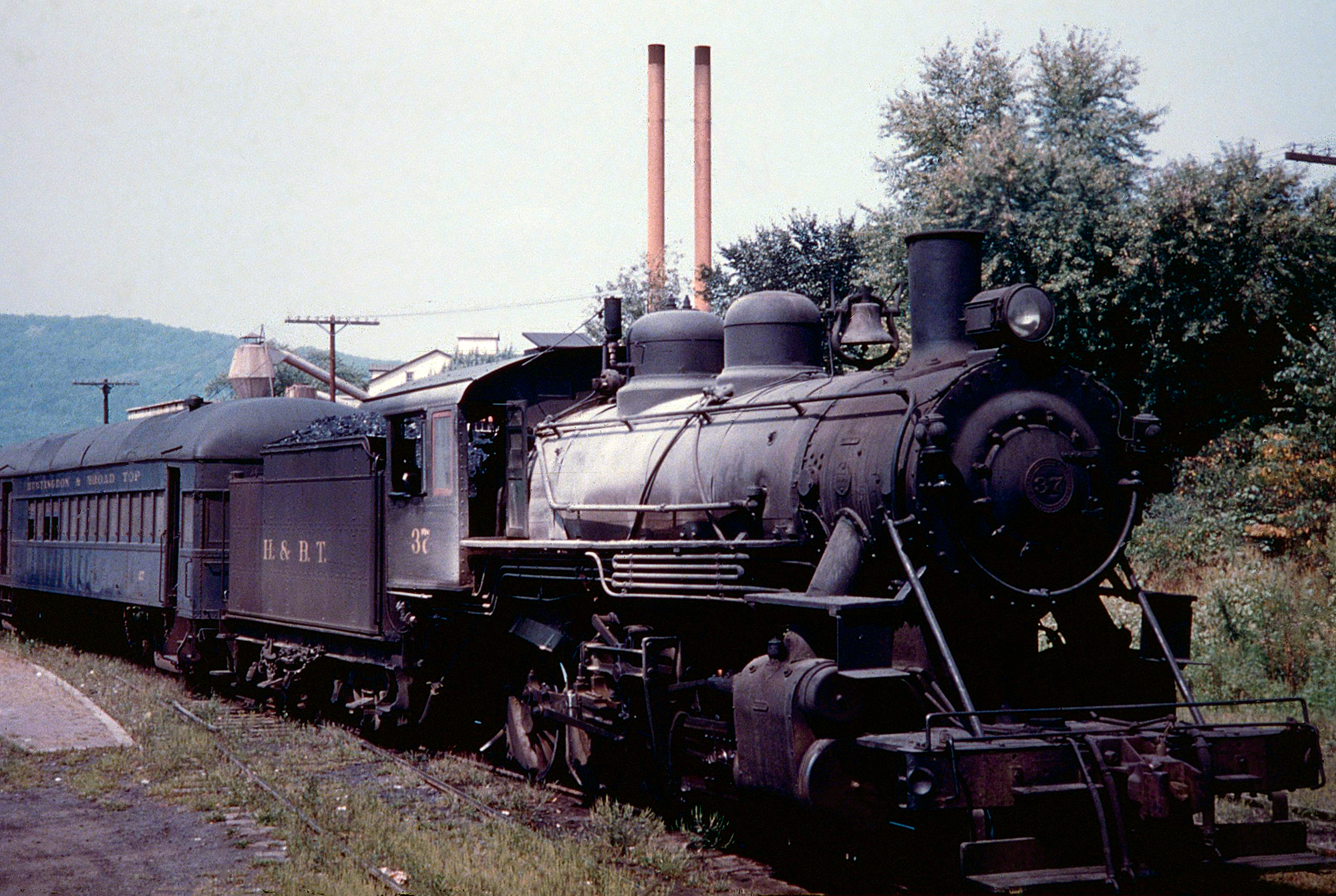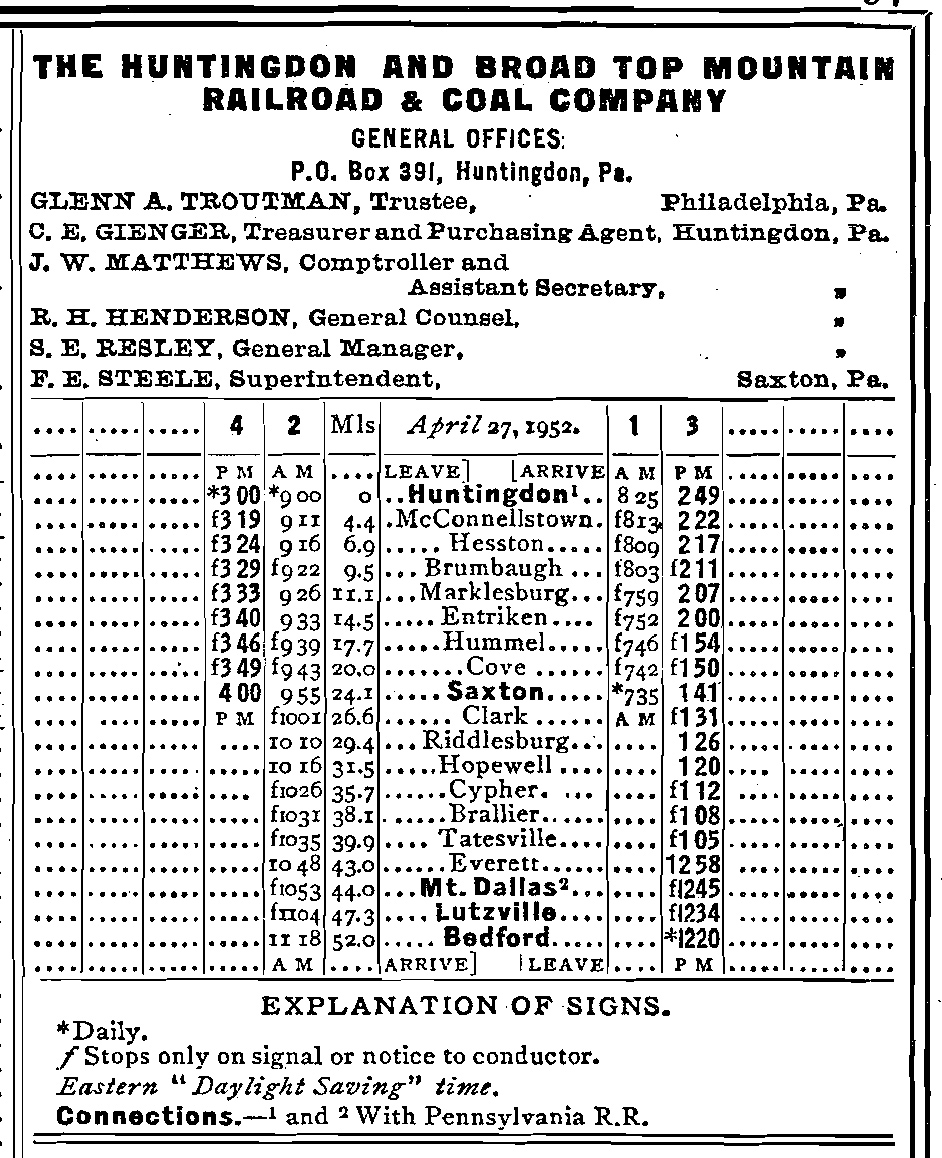Huntingdon and Broad Top Mountain Railroad
Last revised: November 5, 2024
By: Adam Burns
The Huntingdon and Broad Top Mountain Railroad (H&BT), a pivotal player in the development of central Pennsylvania’s coal industry, has a rich history that reflects both the economic aspirations and the industrial evolution of the 19th and early 20th centuries.
This article delves into the origins, growth, challenges, and legacy of the H&BT Railroad, painting a vivid picture of its influence on the region.
The H&BT was opened in the 1850s as both an important transportation artery between Huntingdon to Bedford, as well as serve area coal mines.
It reached its zenith the early 20th century and was an early victim to the industry's declining state after World War II. It declared bankrupcty and ended all operations in 1953.
 Huntingdon & Broad Top Mountain 2-8-0 #37 at Bedford, Pennsylvania; September 15, 1953. Homer Newlon, Jr. photo. American-Rails.com collection.
Huntingdon & Broad Top Mountain 2-8-0 #37 at Bedford, Pennsylvania; September 15, 1953. Homer Newlon, Jr. photo. American-Rails.com collection.Origins and Early Vision
The inception of the Huntingdon and Broad Top Mountain Railroad can be traced back to the abundant bituminous coal deposits in the Broad Top Mountain region of Pennsylvania.
The area's potential to fuel the burgeoning industrial revolution in the United States was immense, but transporting coal from these rugged terrains to the markets posed significant challenges.
In response to this need, the Huntingdon and Broad Top Mountain Railroad and Coal Company was chartered on May 6, 1852. The company’s vision was twofold: to build a railway that would connect the coal-rich regions with broader markets and to exploit the coal resources by engaging in mining operations. This dual focus set the stage for the railroad’s pivotal role in the economic development of central Pennsylvania.
Construction and Early Operations
Construction of the H&BT Railroad commenced in 1853, with the ambitious goal of creating a reliable transportation network from the coal fields around Broad Top Mountain to the Pennsylvania Railroad’s main line at Huntingdon. The terrain was rugged and required innovative engineering solutions, including the construction of tunnels and bridges.
The line from Huntingdon to Saxton, approximately 28 miles, was completed in 1855. The railroad's first section was received with much anticipation and enthusiasm, as it opened up new economic opportunities by facilitating the transportation of coal to broader markets.
The 31-mile segment of the main line stretching from Huntingdon to Hopewell, via Saxton and Riddlesburg, reached completion in 1855. Subsequently, on February 3, 1859, the Bedford Railroad Company was chartered, aimed at establishing a railroad connection for Bedford.
Official incorporation followed on February 19, 1859. With financial backing from the Pennsylvania Railroad (PRR), this company successfully constructed a line connecting Mount Dallas to Hopewell by July 1863, thereby seamlessly integrating with the H&BT. The strategic move culminated in a merger with the H&BT on August 17, 1864, expanding the network significantly.
As the H&BT Rbegan operations, it quickly became evident that the investment was worthwhile. Coal was transported to major cities, powering industries and providing fuel for home heating. The economic benefits were not limited to coal; the railroad also facilitated passenger travel and the transportation of other goods, contributing to the broader economic growth of the region.
Expansion and Economic Impact
At its peak, the company's total track mileage surpassed 72 miles. During this time the system operated a number of coal branches including:
Shoups Run Branch: Spanning from Saxton to Broad Top City via Coalmont and Dudley, this branch was extended to Barnettstown, near Dudley, in 1856. Passenger service operated from Saxton to Dudley exclusively between 1859 and 1917.
Coalmont Branch: This branch extended from Coalmont to Hickory Hill.
Miller's Run Branch: Originating from the Shoups Branch between Coalmont and Dudley, this line stretched to Kenrock and further along Miller's Run. Construction was completed in 1908.
Six Mile Run Branch: Connecting Riddlesburg to North Point via Defiance and Coaldale, this branch was inaugurated up to Defiance in 1862 and subsequently extended.
Shreeves Run Branch: Running from North Point to Finleyville.
Sandy Run Branch: This branch connected Hopewell to the Garlick Mine through Langdondale.
Long's Run Branch: Stretching from Langdondale to Kearney, this branch began operations in 1883.
Kimber Run Branch: This short-lived branch started south of Hopewell at the confluence of Kimber Run and the Raystown Branch of the Juniata River, extending up Broad Top Mountain, and was in operation only for a few years at the beginning of the 20th century.
The economic impact of the H&BT Railroad was profound. Towns along the rail lines experienced growth as new businesses and services emerged to support the mining and transportation activities. Employment opportunities in mining, railroading, and related industries attracted workers, leading to population increases and the establishment of vibrant communities.
The railroad's symbiotic relationship with the coal industry was evident in the period's labor dynamics. Many immigrants, particularly from Europe, settled in the region to work in the mines and on the railroad, contributing to the area's cultural diversity and economic vitality. The H&BT Railroad was not just a transportation network; it was a catalyst for regional development.
Official Guide Listing (1952)
Challenges and Competition
Despite its successes, the H&BT Railroad faced several challenges throughout its history. Economic fluctuations, particularly the periods of recession in the late 19th and early 20th centuries, affected the demand for coal and, consequently, the railroad's revenue.
Maintaining profitability during these downturns required strategic adjustments, including cost-cutting measures and the diversification of freight services.
Competition was another significant challenge. The H&BT Railroad faced competition from other railroads and transportation modes. As technology advanced and transportation infrastructure evolved, alternative methods for transporting coal, such as trucking and conveyor systems, began to emerge. These alternatives posed a threat to the railroad’s dominance in coal transportation.
Additionally, labor relations presented ongoing challenges. The railroad industry, including the H&BT Railroad, experienced labor strikes and disputes over working conditions and wages. These labor issues sometimes disrupted operations and required careful negotiation to resolve.
Decline and Legacy
The post-World War II era brought about significant changes in the transportation and energy sectors. The decline of the Broad Top Mountain coal fields, coupled with the maturity of construction bonds and a series of ill-advised right-of-way improvements and equipment purchases, severely impacted the financial stability of the Huntingdon and Broad Top Mountain Railroad (H&BTM).
Consequently, the H&BTM declared bankruptcy on October 11, 1953. The railroad operated its final passenger train in November 1953 and ceased all operations on March 31, 1954.
On April 1, 1954, the Everett Railroad assumed control of the southernmost four miles of H&BTM trackage, spanning from Tatesville to Mount Dallas.
This segment remained operational until 1982, when the Everett Railroad shut down due to Conrail's abandonment of the Bedford Division, then known as Conrail's Bedford and Mount Dallas Branches. The tracks were subsequently removed in 1985.
In a separate transaction, the railroad's trackage located in Huntingdon, Pennsylvania, was sold to the Pennsylvania Railroad (PRR). The PRR, along with its successors Penn Central and Conrail, utilized this track to access an industrial park in the Smithfield area of Huntingdon. While the northern portion of the trackage remains in place, it has not been in use since the late 1990s.
Conclusion
The history of the Huntingdon and Broad Top Mountain Railroad is a testament to the transformative power of transportation infrastructure.
From its origins in the mid-19th century to its closure in the mid-20th century, the H&BT was a vital conduit for coal transportation and economic development in central Pennsylvania. Its story reflects the broader themes of industrialization, technological innovation, and regional growth that characterized American history during this period.
As we reflect on the legacy of the H&BT, we are reminded of the profound impact that railroads had on shaping the economic and social landscapes of the United States.
The H&BT may no longer be operational, but its contributions to the history and development of central Pennsylvania remain a significant chapter in the narrative of American railroading.
Recent Articles
-
Rio Grande 2-8-2 Locomotives (K-37): Specs, Roster, Photos
Apr 15, 25 12:57 PM
Rio Grande's Class K-37 Mikes were itsdge steamers to enter service in the late 1920s. Today, all but two survive. -
Rio Grande 2-8-2 Locomotives (K-36): Specs, Roster, Photos
Apr 15, 25 11:09 AM
The Rio Grande's K-36 2-8-2s were its last new Mikados purchased for narrow-gauge use. Today, all but one survives. -
Rio Grande 2-8-2 Locomotives (Class K-28): Specs, Roster, Photos
Apr 14, 25 10:24 PM
Rio Grande's Class K-28 Mikados were its newest narrow-gauge steam locomotives since the Mudhens of the early 1900s. Today, three survive.



